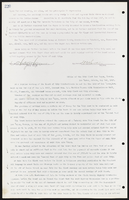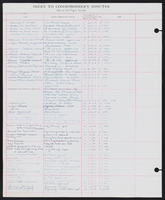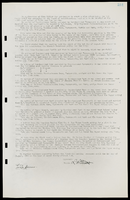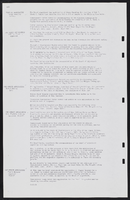Search the Special Collections and Archives Portal
Search Results
Rex Bell Jr. oral history interview
Identifier
Abstract
Oral history interview with Rex Bell, Jr. conducted by Claytee D. White on March 02, 2010 for the Boyer Early Las Vegas Oral History Project. Bell Jr. discusses growing up on the Walking Box Ranch, as the son of movie stars Rex Bell and Clara Bow, and attending law school. He also discusses working in Las Vegas, Nevada with his own law practice and race relations in the city.
Archival Collection

Transcript of interview with Mary Kreuzer by Patricia Kohlman, December 15, 1975
Date
Archival Collection
Description
On December 15, 1975, Patricia Kohlman interviewed Mary Kreuzer (born 1923 in Las Vegas, Nevada) in her home in Las Vegas. The two discuss Kreuzer’s childhood, as well as the different addresses that she’s lived at in Las Vegas. The interview concludes with a discussion on entertainment and small businesses before the population boom in Southern Nevada.
Text
Mummified remains of a Native American known as Queho: photographic print
Date
Archival Collection
Description
From the Nye County, Nevada Photograph Collection (PH-00221) -- Series IV. Pahrump, Nevada -- Subseries IV.D. Wiley Family. Mummified remains of an Indian renegade known as Queho. Many years previous to when this photo was taken in the early 1940, Queho is said to have killed and robbed a number of individuals in the Searchlight, Nevada area. Unsuccessful efforts were made to to apprehend Queho. In the early 1940, the men pictured here on the left and right were exploring an area along the Colorado River when they saw a cave in the cliffs above the river. They climbed up to the cave and Queho's remains were found. Research established that the remains were Queho’s because several of the artifacts he had stolen from people in Searchlight accompanied the remains. Queho’s remains were turned over to the Palm Mortuary in Las Vegas when a question arose there as to who would pay for the expenses of keeping Queho there and his burial. Roland Wiley, district attorney for Clark County, Nevada, at that time, suggested that the remains be turned over to the Elks Lodge, where for a number of years they were exhibited on the Helldorado grounds during Helldorado Days in a glass display case with some of the stolen artifacts. Queho’s remains were stolen from the Elks on two occasions, and each time they were recovered. Jim Cashman, head of the Las Vegas Elks at that time, grew tired of worrying about the theft of Queho’s remains, so they moved to a building belonging to Dobie Doc Caudill near the Tropicana Hotel. Roland Wiley purchased Queho’s remains from Dobie Doc for $100 and buried them near Cathedral Canyon, located on Wiley’s ranch in Pahrump Valley overlooking his Hidden Hills airstrip, in concrete and steel so they could not be easily stolen again. Wiley believed the Indian deserved a decent burial and buried popcorn with the remains to accompany Queho on his journey. Standing second from the left is Frank Waite, chief of police in Las Vegas for many years. Waite was a member of the posse that initially searched for Queho.
Image

Joseph Kine interview, March 02, 1976: transcript
Date
Archival Collection
Description
On March 2, 1976, collector Debbie Nesbit interviewed Joseph Kine (born November 16th, 1906 in Elkhart, Iowa) in his home in Boulder City, Nevada. In this interview, Mr. Kine discusses working at Hoover Dam (Boulder Dam) as a high scaler. He also speaks about living in Boulder City in its very beginnings as a town.
Text
Harry Reid oral history interviews
Identifier
Abstract
Oral history interviews with Harry Reid conducted by Claytee D. White on July 28, 2017, December 1, 2017, August 8, 2019, and September 12, 2019 for the Boyer Early Las Vegas Oral History Project. In the first interview, Senator Harry Reid talks about his experiences as chairman of the Nevada Gaming Commission from 1977 to 1981. He discusses casino decisions related to the Stardust Resort and Casino, the Fremont Hotel, the Aladdin Hotel and Casino, and the Hacienda Resort Hotel and Casino as well as the FBI requesting wiretaps and the Nevada Gaming Commission issuing gaming licenses at that time. In the second interview, Reid shares details as city attorney in Henderson, Nevada, his work with the University Medical Center Hospital Board, and case details as an attorney with the firm of Singleton, DeLanoy, and Jemison. Some of the cases he describes include litigation against Safeway stores, charges of drugs and murder, and evictions.
In the third interview, Reid discusses his term serving the United States House of Representatives and his role as Senate Majority Leader. He recalls his election to Nevada Assembly in 1968, his tenure as Lieutenant Governor of Nevada from 1971 to 1975, his position as chairman of the Nevada Gaming Commission from 1977 to 1981, and his position as Nevada's delegate in the United States House of Representatives from 1983 to 1987. Reid also talks about his political defeats when running for United States Senate and for Mayor of Las Vegas. In the fourth interview, Reid talks about various significant sites in Nevada including Searchlight, Yucca Mountain, and the Nevada Test Site.
Archival Collection
J. W. Sligar Land Surveying Notebooks
Identifier
Abstract
The J.W. Sligar Land Surveying Notebooks (1973-2002) consist of notebooks with measurements, boundaries, construction calculations, and mapping for land surveys of Southern Nevada, principally the Las Vegas Valley. Projects concern both public and private entities. The notebooks were created as a part of J.W. Sligar's work with ALCA Engineering and and Surveying, Inc, as well as for his own company, J.W. Sligar Surveying.
Archival Collection




